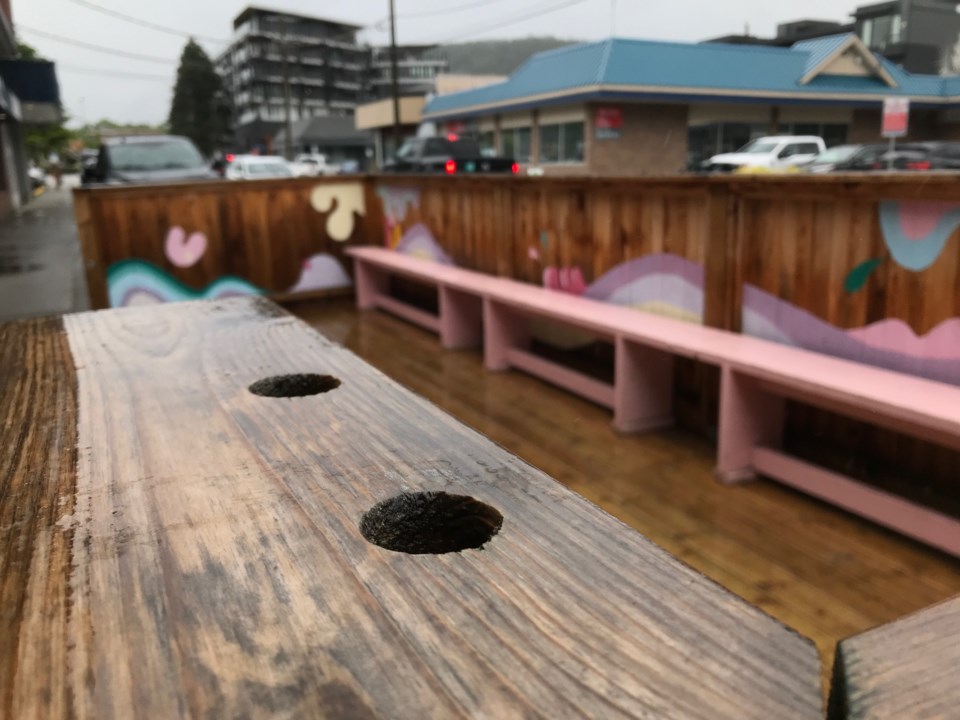With summer just around the corner, patio season has begun, thanks to a revamped patio program that was initially introduced during the pandemic.
Since restaurants were hit with restrictions that had placed major limitations on the number of people that were allowed to dine inside, the municipality adapted by creating the temporary patio program.
Squamish, along with a number of other municipalities provincewide, created regulations that allowed food service businesses to create quick and safe outdoor extensions of their restaurants and cafes.
On May 3 the District unanimously voted to adopt new regulations that will keep the patio program in place, while instituting what it considers to be improvements.
One of the highlights of the new program is a streamlined process that consolidates business applications into one form for all three different styles of patios:; District curbside patios, District sidewalk patios, and private land patios.
The new program also allows the municipality to charge a fee for land use.
“The goal of the fee structure would be to help offset application and processing time to review these patio applications but is not designed to compensate for land use costs,” a staff report reads.
During the public hearing on this matter, which occurred on April 19, only one person spoke out with concerns about the proposal.
Marie-Louise Towers identified herself as a downtown business owner.
“There are three stalls taken up by patios directly north of my store. So it does have a big impact on my customers,” said Towers.
She said she was supportive of patios in general, but did not agree with using parking stalls to provide very low cost space to other businesses when it impacted her business.
“I pay a lot of money to rent this size of space that I have,” said Towers.
“I pay a lot of municipal tax. I'm not getting free space anywhere. And I couldn't use that free space anywhere anyway, because I have a product that I have to display. So I do support trying to keep restaurants vibrant, especially during COVID. But throughout this whole winter, of those three parking stalls that are taken up directly north of my store, two of them were never ever shoveled off.”
In response, planner Kerry Hamilton said that the new bylaw would address issues in the current set of regulations.
Patios would have a cost, and they cannot be kept up indefinitely if they’re not being used, she said.
“The amended program that was proposed to council spoke to adding fees for these patios,” said Hamilton. “So they're no longer just for free for those businesses. [There are new] design considerations. One of them being that if you are not going to use your patio in the winter, you cannot keep it there. So there won't be some of the concerns that we did experience last year, [such as cases where some] patios were just accumulating snow and weren't being used.”
The new fee schedule is $175 per application for a patio with a less than 30-person occupancy. The fee jumps to $300 for patios intended for more than 30 occupants. Finally, there is an annual licence renewal charge of $50 when the patio is on District land.
Coun. Jenna Stoner said that the new fee structure should address some of the concerns about the municipality giving away space for free.
“We have made significant efforts as we brought in the new patio program by introducing a fee for that public space,” said Stoner.
“So hopefully that reduces the idea that [they are] being subsidized, but I also want to address the fact that many of the patios that I have seen come forward are not necessarily being held specifically for that business. They are potentially benefiting that one business, but I've noticed that they're also very open to the public.”
Coun. Doug Race said that while the pandemic has been challenging, the new patio program is one bit of good news to come through the last two years.
On the other hand, Coun. Eric Andersen said that he’d like to see more housekeeping measures taken with respect to the parking issues.
He wound up approving the measure, but said an updated parking strategy is needed.
“Although there are some concerns around downtown parking availability, they are likely not caused by patios on their own,” said Andersen. “Therefore, these concerns may be better addressed through a list of parking strategy elements, zoning elements and transportation.”



